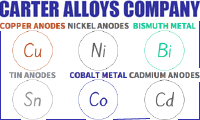
Curated with aloha by
Ted Mooney, P.E. RET

The authoritative public forum
for Metal Finishing 1989-2025

-----
Anode/cathode efficiency issue is generating too much copper sulphate in Acid Copper Plating
Q. We are an acid copper plating shop in Kolkata India. We are plating 250 microns copper on steel rounds. Due to difference in anode/cathode efficiency we are generating CuSO4 in good quantities. How can we increase cathode efficiency? We are not using any brighteners and plate at 125 ASF. What should be solution pH?
MANOJ BUDHIAENGSER LTD - KOLKATA, INDIA
2005
A. As a general rule, acid copper is plated at 20 to 100 amps/sq ft. You may have a proprietary bath that can stand that amperage.
It is best to control an acid copper tank by analysis (titration) of sulfuric acid than by pH. How do you control your chloride?
- Navarre, Florida
2005
Q. We do the same thing plating wise and we do constant dilution to control CuSO4; please suggest more ways to control anode/cathode efficiency and how to reduce generation of CuSO4.
Thanks
electrical - dubai, uae
June 24, 2014
A. Hi Richard. First, are you using phosphorized copper anodes? "Role of Phosphorus in Acid Copper Anodes" by G V Tilburg, published in the May 1977 issue of Metal Finishing shows how the P lowers electrical conductivity and decreases anode efficiency to reduce this problem of anode efficiency exceeding cathode efficiency. Good luck.
Regards,

Ted Mooney, P.E.
Striving to live Aloha
finishing.com - Pine Beach, New Jersey
June 2014
Q. Continuing on your above response, I would like to state that we feel our anode efficiency is higher than cathode efficiency; that's the reason we use phosphor. We would like to maintain an equilibrium between anode and cathode efficiency. We use acid copper baths. Also if there is equilibrium between the anode and cathode then there won't be any CuSO4 generation, right? Are there ways to increase cathode efficiency without decreasing anode efficiency?
Thank You.
electrical - Dubai,UAE
June 30, 2014
A. Hi Richard. There are ways to do it, but I don't know that they are practical.
Faraday's Law is always satisfied, but inefficiency results from the electrolysis of water into hydrogen gas & OH- in lieu of the deposition of copper. A way to decrease this inefficiency is to assure that copper ions are always available when there is an excess electron at the cathode. And that can be done by increasing the agitation right at the cathode in order to thin the boundary layer -- this is sometimes done by spraying jets of solution onto the parts. Another way to increase efficiency that you will dislike is to reduce the current and therefore the production rate :-)
Regards,

Ted Mooney, P.E.
Striving to live Aloha
finishing.com - Pine Beach, New Jersey
June 2014
A. Hi Richard,
You can try using inert anodes -- e.g., platinised Ti -- in conjunction with your P-Cu anodes. You will have to play with this a bit to find the right anode ratio between inert and P-Cu anode to reduce the anode efficiency to the cathode efficiency value. If you put in too much inert anodes your copper concentration will be then going down.
I would recommend to spread the inert anodes along all plating tank -- do not concentrate them just in one point since the appearance of the copper plating could be different.
- Manchester, UK
July 3, 2014
A. Some acid-copper sulphate
⇦ this on
eBay or
Amazon [affil links] operations use only insoluble (inert) anodes, and make up for copper depletion / acidification with regular cupric oxide/hydroxide additions. This would obviously cure any cupric sulphate accumulation issues. I'm guessing that cathode current efficiency can also be raised by this method; I'd have to check my notes.
I only have personal experience with ball anodes, but suppliers have offered process technology solutions based on using insolubles alone. You can buy the oxide/hydroxide paste, or use a unit they call a "copper gobbler" to oxidize balls or scrap, on-site. I've forgotten the exact reactions for the gobbler, but I'll bet that Google knows.
Best of luck to all.
Greaves Mechatronic (PCB and planar device fabrication) - Toronto, Ontario, Canada
September 26, 2014
![]() Thanks for the enlightenment, Mike, I had never heard of this very interesting technology.
Thanks for the enlightenment, Mike, I had never heard of this very interesting technology.
Regards,

Ted Mooney, P.E.
Striving to live Aloha
finishing.com - Pine Beach, New Jersey
September 2014
adv.: Supplier of Copper Anodes, Nickel Anodes, Bismuth Metal, & Other Metal Products for Industry & The Arts

Q, A, or Comment on THIS thread -or- Start a NEW Thread